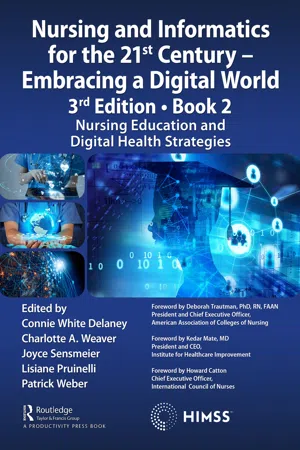
Nursing and Informatics for the 21st Century - Embracing a Digital World, 3rd Edition - Book 2
Nursing Education and Digital Health Strategies
- 210 pages
- English
- ePUB (mobile friendly)
- Available on iOS & Android
Nursing and Informatics for the 21st Century - Embracing a Digital World, 3rd Edition - Book 2
Nursing Education and Digital Health Strategies
About This Book
Nursing Education and Digital Health Strategies explores the current state of health and healthcare education, as well as that of nursing informatics education. These topics include technologies-enabled education for all nurses and interprofessional collaborations from a worldwide perspective. The "New" learning for applied critical thinking will include technology, content, skills versus tools, and the use of "smart" systems for care delivery, the role of critical thinking, and uniqueness of nursing care delivery. Further, how these changes are understood as a paradigm shift that needs to be incorporated along with nursing and healthcare education is emphasized. The effects of technology on human behavior are also explored, addressing human–factors interaction, interdependence of human–computer interaction, and other effects of technology on wellbeing. As part of nursing education, learning from clients/patients to better shape and advance nursing education and scholarship are discussed. Academic–clinical practice partnerships for a digital future, how teams are working together (clinician/teacher) for better healthcare delivery and applied knowledge—including joint appointments (exchange of academia and applied expertise), academic–applied human resources, and interprofessional learning/development—are discussed.
This book closes by discussing and using case studies to showcase nursing competencies for the next decade, implications for preparing the healthcare workforce for a digital world, faculty readiness, and the interaction with gaming and simulations. Nursing informatics education, including continuing education beyond academia, i.e., informal education, worldwide, as well as global challenges to support digital world capabilities are described. Hands-on Experiential Delivery and learning-based case studies are also included.
Nursing and Informatics for the 21st Century – Embracing a Digital World, 3rd Edition is comprised of four books which can be purchased individually:
Book 1: Realizing Digital Health – Bold Challenges and Opportunities for Nursing
Book 2: Nursing Education and Digital Health Strategies
Book 3: Innovation, Technology, and Applied Informatics for Nurses
Book 4: Nursing in an Integrated Digital World that Supports People, Systems, and the Planet
Frequently asked questions
Information
Chapter 1
Nursing Informatics Educational Programs in Academia and in Practice
Introduction
The Need for Informatics Education
What Are Informatics Skills and Competencies?
Table of contents
- Cover
- Half-Title
- Series
- Title
- Copyright
- Dedication
- Contents
- Foreword by Deborah Trautman
- Foreword by Kedar Mate
- Foreword by Howard Catton
- Preface
- Acknowledgement
- Editors
- Contributors
- Introduction
- 1 Nursing Informatics Educational Programs in Academia and in Practice
- 2 International Health and Healthcare Education Current State
- 3 Health and Healthcare Education Current State
- 4 Using Digital as a Tool, Not Being the Tool of the Technology Giants
- 5 Learning from Clients/Patients to Advance Education and Scholarship
- 6 Cultivating a Workforce of Nurse Disruptors: An Academic–Practice Innovation Hub
- 7 Nursing Education and Digital Health Strategies
- 8 Nursing Informatics Competencies for the Next Decade
- 9 Interprofessional Practice and Education: Interrelationship with Knowledge Generation, the IPE Core Data Set and National Information Exchange Infrastructure
- 10 The use of the IMIA Education Recommendations and the IMIA Knowledge Base as a Foundation for Competencies in Health Informatics in Africa
- 11 Simulation-Based Learning from across the Globe
- Index